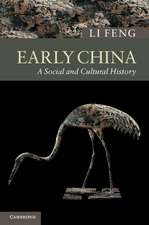Rambles and Recollections of an Indian Official: Cambridge Library Collection - South Asian History
Autor W. H. Sleemanen Limba Engleză Paperback – 15 iun 2011
| Toate formatele și edițiile | Preț | Express |
|---|---|---|
| Paperback (2) | 466.75 lei 6-8 săpt. | |
| Cambridge University Press – 15 iun 2011 | 466.75 lei 6-8 săpt. | |
| Cambridge University Press – 15 iun 2011 | 466.75 lei 6-8 săpt. |
Din seria Cambridge Library Collection - South Asian History
- 19%
 Preț: 657.70 lei
Preț: 657.70 lei -
 Preț: 365.17 lei
Preț: 365.17 lei - 23%
 Preț: 1213.80 lei
Preț: 1213.80 lei - 23%
 Preț: 833.69 lei
Preț: 833.69 lei -
 Preț: 361.59 lei
Preț: 361.59 lei -
 Preț: 466.53 lei
Preț: 466.53 lei -
 Preț: 282.85 lei
Preț: 282.85 lei -
 Preț: 429.29 lei
Preț: 429.29 lei -
 Preț: 421.42 lei
Preț: 421.42 lei -
 Preț: 407.01 lei
Preț: 407.01 lei -
 Preț: 518.89 lei
Preț: 518.89 lei -
 Preț: 374.08 lei
Preț: 374.08 lei -
 Preț: 467.71 lei
Preț: 467.71 lei -
 Preț: 498.41 lei
Preț: 498.41 lei - 19%
 Preț: 478.25 lei
Preț: 478.25 lei - 19%
 Preț: 455.62 lei
Preț: 455.62 lei -
 Preț: 367.33 lei
Preț: 367.33 lei -
 Preț: 251.55 lei
Preț: 251.55 lei -
 Preț: 522.55 lei
Preț: 522.55 lei - 19%
 Preț: 469.32 lei
Preț: 469.32 lei -
 Preț: 246.93 lei
Preț: 246.93 lei - 19%
 Preț: 627.95 lei
Preț: 627.95 lei -
 Preț: 241.27 lei
Preț: 241.27 lei -
 Preț: 287.95 lei
Preț: 287.95 lei -
 Preț: 519.66 lei
Preț: 519.66 lei -
 Preț: 444.95 lei
Preț: 444.95 lei -
 Preț: 472.37 lei
Preț: 472.37 lei -
 Preț: 422.77 lei
Preț: 422.77 lei -
 Preț: 278.99 lei
Preț: 278.99 lei -
 Preț: 522.55 lei
Preț: 522.55 lei -
 Preț: 356.96 lei
Preț: 356.96 lei -
 Preț: 408.91 lei
Preț: 408.91 lei -
 Preț: 248.46 lei
Preț: 248.46 lei -
 Preț: 238.00 lei
Preț: 238.00 lei
Preț: 466.75 lei
Nou
Puncte Express: 700
Preț estimativ în valută:
89.31€ • 93.26$ • 73.75£
89.31€ • 93.26$ • 73.75£
Carte tipărită la comandă
Livrare economică 15-29 aprilie
Preluare comenzi: 021 569.72.76
Specificații
ISBN-13: 9781108092302
ISBN-10: 1108092306
Pagini: 504
Ilustrații: 7 b/w illus.
Dimensiuni: 140 x 216 x 29 mm
Greutate: 0.64 kg
Editura: Cambridge University Press
Colecția Cambridge University Press
Seria Cambridge Library Collection - South Asian History
Locul publicării:Cambridge, United Kingdom
ISBN-10: 1108092306
Pagini: 504
Ilustrații: 7 b/w illus.
Dimensiuni: 140 x 216 x 29 mm
Greutate: 0.64 kg
Editura: Cambridge University Press
Colecția Cambridge University Press
Seria Cambridge Library Collection - South Asian History
Locul publicării:Cambridge, United Kingdom
Cuprins
Dedication; 1. Annual fairs held upon the banks of sacred streams in India; 2. Hindoo system of religion; 3. Legend of the Nerbudda River; 4. A suttee on the Nerbudda; 5. Marriages of trees. The tank and the plaintain. Meteors. Rainbows; 6. Hindoo marriages; 7. The purveyance system; 8. Religious sects. Self-government of the castes. Chimney-sweepers. Washerwomen. Elephant-drivers; 9. The great Iconoclast. Troop routed by hornets. The Ranee of Gurba. Hornets' nest in India; 10. The peasantry and the land settlement; 11. Witchcraft; 12. The silver tree, or kulpa briksha. The Singhara, or trapa bispinosa, and the Guinea worm; 13. Thugs and poisoners; 14. Basaltic cappings of the sandstone hills of central India. Suspension bridge. Prospect of the Nerbudda valley. Deification of a mortal; 15. Legend of the Sauger Lake. Paralysis from eating the grain of the Lathyrus sativus; 16. Suttee tombs. Insalubrity of deserted fortresses; 17. Basaltic cappings. Interview with a native chief. A singular character; 18. Birds' nests. Sports of boyhood; 19. Feeding pilgrims. Marriage of a stone with a shrub; 20. The men-tigers; 21. Burning of Deoree by a freebooter. A Suttee; 22. Interview with the Rajah who marries the stone to the shrub. Orders of the Moon and the Fish; 23. The Rajah of Orcha. Murder of his many ministers; 24. Corn dealers. Scarcities. Famines in India; 25. Epidemic diseases. Scape-goat; 26. Artificial lakes in Bundelcund. Hindoo, Greek, and Roman faith; 27. Blights; 28. Pestle and mortar sugar-mills. Washing away of the soil; 29. Interview with the chiefs of Jansee. Disputed succession; 30. Haunted villages; 31. Interview with the Rajah of Duteea. Fiscal errors of statesmen. Thieves and robbers by profession; 32. Sporting at Duteea. Fidelity of followers to their chiefs in India. Law of primogeniture wanting among Mahomedans; 33. Bhoomeeawut; 34. The suicide. Relations between parents and children in India; 35. Gwalior plain once the bed of a lake. Tameness of peacocks; 36. Gwalior and its government; 37. Contest for empire between the sons of Shah Jehan; 38. Ourungzebe and Moorad defeat their father's army near Ojeun; 39. Dara marches in person against his brothers, and is defeated; 40. Dara retreats towards Lamore. Is robbed by the Jats. Their character; 41. Shah Jehan imprisoned by his two sons, Ourungzebe and Moorad; 42. Ourungzebe throws off the mask, imprisons his brother Moorad, and assumes the government of the empire; 43. Ourungzebe meets Shoojah in Bengal and defeats him, after pursuing Dara to the Hyphasis; 44. Ourungzebe imprisons his eldest son. Shoojah and all his family are destroyed; 45. Second defeat and death of Dara, and imprisonment of his two sons; 46. Death and character of Ameer Jumla; 47. Reflections on the preceding history; 48. The great diamond of Kohinoor.
Descriere
A wide-ranging two-volume portrait of India written by a British colonial official who lived there for more than thirty years.














